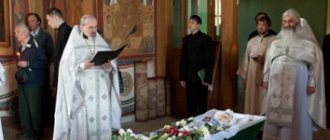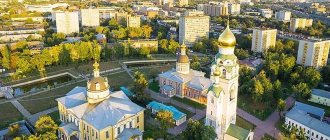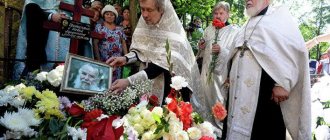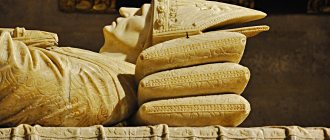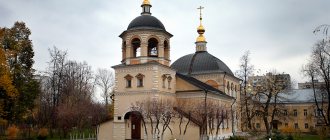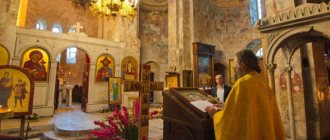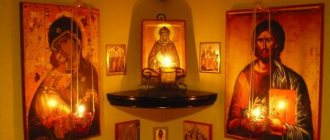Old Believers are people who failed to accept the new form of Orthodoxy. Like all baptized Christians, they believe in one God, in his son Jesus Christ, in the sacrifice he made for the salvation of mankind. But their beliefs are strikingly different from modern church canons. They make the sign of the cross with two fingers, the crosses are eight-pointed and without a crucifix, and they have their own school of icon painting. But, first of all, the Old Believers are a special way of life and a unique organization of body burial.
Old Believers try to preserve the traditions and customs passed on to them by previous generations. But while remaining part of the modern world, they cannot help but change. Thus, modern followers of the “true faith” no longer grow flax or weave funeral vestments for themselves, or hew coffins from tree trunks, but some rituals are still practiced unchanged.
Preparation for death and first rituals
According to all canons, Old Believers begin preparing for the moment of death in advance. Of course, if we are talking about expected death at an old age. Thus, dying without confession is considered a bad sign, but inviting an Orthodox priest to it is an even greater sin. You can speak out to a mentor or elder in the community. When preparing for death, an Old Believer must repent of his misdeeds, forgive all loved ones against whom he once held a grudge, and express parting words and his last will. If the deceased did not have time to confess, his fate is entrusted to the hands of the Lord without a funeral service. In this case, the deceased is awarded only a prayer for the departure of the soul.
When the spirit leaves the body, the relatives of the deceased begin to perform a series of classical rituals:
- Mourning. In some communities, crying is considered a shameful act, but the majority of Old Believers believe that only a well-mourned soul can calmly leave the world of the living and not return back. Preparation for a death begins in advance, so by the time of death, professional mourners have already been invited to the house of the deceased. The lamentation begins almost from the first minute of death;
- Mirrors. Hanging mirrors is one of the most ancient customs. On the day of death, not only the mirror is covered, but also any reflective surfaces: polished samovars, metal household utensils, tinted glass, monitors, etc.;
- Ablution. According to tradition, the deceased must be washed immediately after death, before the body cools down. They do this at home. The most senior members of the family or community are invited to carry out the procedure. Women are washed by women, men by men. But if there are not enough people, exceptions are allowed;
Ablution always begins on the right side. Water, washcloth and combs are buried in an untrodden place outside the populated area.
- Vestment. Today, funeral clothes are no longer sewn from hand-made linen, but are prepared in advance. It is customary to bury people in white underwear and linen shirts (men's go to the knees, women's to the toes). Men also wear pants without tucking in their shirt; women wear a dark sundress without decorations or knots. For women, their hair is braided into a tight braid and covered with a scarf (without tying). Before being placed in the coffin, the body was swaddled in a shroud.
Body preparation
Old Believers usually begin wailing right from the moment the fact of death is established. Often, mourners were always invited for such purposes, and experienced complainers could always touch those present with their lamentations.
Absolutely all mirror surfaces throughout this house were curtained without fail. This even applied to mirrors, polished metal doors and samovars.
Cleansing of all bodily integuments was always carried out in the first hours after death. Due to the serious labor intensity, this was always done by 2-3 people. They always started with the head and ended with the feet. The right side was always washed before the left. Epiphany water was often used for such purposes. After ablution, such water was never poured out in public places.
Clothes were always prepared earlier - these were an undershirt, socks, and for women - stockings, soft slippers made of leather, straw or coarse fabric. The women's shirt reached to the ankles, the men's - to the knees.
Entombment
Modern supporters of the Old Believers no longer adhere to the strict canons of preparing the coffin. They do not hew a coffin out of a single tree trunk, nor do they resort to ancient methods of knocking together a coffin without nails. Wood shavings and straw were also no longer used as filling. And no one keeps lost hair for the rest of their lives so that after death they can stuff their pillow with it. But some rules remained unshakable:
- The deceased is placed with his feet towards the icons;
- Hands are placed on the chest (right on top of left). The fingers are collected in a gesture for the sign of the cross (two fingers);
- An icon of the patron saint and a cross are placed on the chest (they are removed before being taken out of the house).
To keep the body and the lid of the coffin tight, they are tied with a whip. The rope is tied in such a way that on the outside there is an eight-pointed cross - a symbol of the former faith.
How Old Believers prepare for burial
Before leaving for the last resting place of the deceased, the Old Believers adhered to the following procedure:
- mourners lament continuously from the moment of death to burial;
- All mirrors and shiny surfaces in the house (monitors, TVs, metal utensils) are covered;
- the old people wash the body, after which all the belongings and water are buried far outside the city or village;
- the deceased is dressed in dark-colored clothes prepared during life and placed in a white shroud, girls have a braid, and married women have 2 braids;
- It was customary to carve the coffin from a single piece of wood; It was considered right to make a coffin for yourself during your lifetime and store it in the attic; modern Old Believers use simple wooden coffins; It is not customary to upholster the coffin and decorate it with a crucifix; branches, leaves, chips and shavings are placed at the bottom;
- the deceased is placed in a coffin and an icon and a cross are placed in his hands, which are taken out before closing the coffin;
- They close the coffin and tie it with bast in such a way that it looks like an octagonal Old Believer cross.
Funeral rites
Traditionally, funerals are held on the third day after death. However, given that the Old Believers do not resort to embalming, the dates may shift during hot periods. Initially, it was prescribed to read psalms without stopping all the time before burial. To do this, 3-4 people were invited to the house of the deceased, replacing each other. It was believed that the more time spent on the funeral service, the purer the soul will appear before the Almighty.
Today, the funeral service is held three times: in the evening before the funeral, in the morning on the day of burial and in the graveyard before lowering the coffin. It should be noted that only righteous souls have the right to purify themselves. If a person led an immoral lifestyle (drank, committed adultery, was not legally married, committed other crimes against people and faith), after his death only the prayer of departure was read, leaving the decision solely with God.
They say goodbye to the deceased on the street in front of the threshold of his house. Tables are also set here so that the deceased can dine with friends before the upcoming journey. When the body is ready to be removed, the coffin is covered with a lid without a cross (the symbol of faith cannot be buried in the ground). Considering the modern pace of life and the distance to cemeteries, walking processions to the churchyard are no longer practiced. The coffin is placed in the ground so that the head is oriented to the west and the legs to the east.
Family rituals
Tradition of creating communities
It is worth noting that the Old Believers have preserved the tradition of uniting into fairly large communities. Communities develop their own routines and rules of conduct. And the people there speak a peculiar dialect, based on the Old Church Slavonic language and its remnants in Old Russian. It is extremely difficult for a simple Russian speaker to immediately understand what he hears in such a dialect. However, people who have lived in the community for about a month begin to actively talk at the same level.
It is customary to form families within communities. That is, among the Old Believers, the feature of the Christian tradition of getting married is preserved. But its official registration occurs much later than the wedding. Usually this moment is scheduled for the birth of the first child in the family.
Children in the communities do not attend nurseries or any pre-school institutions. The elders are involved in their upbringing. The transfer of the first worldly wisdom to children is entrusted to their shoulders.
Baptism
The customs and traditions of the Old Believers are so strong that their violation or non-compliance is highly fraught with danger for community members. The same applies to the rite of baptism, which occurs immediately after the birth of a child. After discharge, the child is sent to a house of prayer or to the parents' house. Dipping should be carried out in a font, the water in which is strictly river.
The strict rule is that at the time of baptism, natural parents do not have the rule to be present during the process. Moreover, they can only see the child at the end of the night. If this rule is violated, then the parents will face a divorce, which is possible among the Old Believers, but is considered a great crime.
It is customary to choose godparents from among relatives. This is also a strict rule, which is based on the creation of “godfathership” within the family. The godparents must put two attributes on the child’s body: a cross and a special belt, which is a talisman for the baby and is not removed throughout his life.
Naming
After baptism, it is customary to immediately name the child. Before this process, choosing a name is prohibited. It is believed that the rite of baptism must follow before the naming. The name of the newborn is selected solely based on the calendar - holy holidays marked in the calendar. You can choose a day either eight days before your birth date or eight days after. The last word remains with the elder of the community.
Pages of history
The word “shroud” comes from the Arab city of Sabana, where craftsmen made a special snow-white material. However, burial cloth has been used since antiquity. During excavations, archaeologists find a lot of evidence that people were buried in simple posthumous clothing.
In eastern countries, wooden products were rarely found, so fabric products were an alternative to coffins. Those families in Rus' who could not afford a dignified farewell with all the ritual attributes did exactly the same thing.
Scientists have discovered official evidence that Peter I introduced a ban on the use of pine and oak raw materials for the production of coffins. He argued that “government property” should not be wasted, subjected to senseless rot. For this purpose, a special decree was even adopted in 1723. After this, the dead people began to be buried in inexpensive coffins made of spruce boards or even only in cloth.
The current life of the Old Believers and their traditions
The discovery of a settlement of Old Believers in 1978 excited the entire space of the then existing Soviet Union. Millions of people literally “stuck” to their televisions to see the way of life of the hermits, which has practically not changed since the times of their grandfathers and great-grandfathers.
Currently, there are several hundred settlements of Old Believers in Russia. Old Believers themselves teach their children; old people and parents are especially revered. The entire settlement works hard, all vegetables and fruits are grown by the family for food, responsibilities are distributed very strictly.
A random visiting guest will be received with goodwill, but he will eat and drink from separate dishes, so as not to desecrate the members of the community. Cleaning the house, doing laundry and washing dishes is carried out only with well or spring running water.
Sacrament of Baptism
Old Believers try to carry out the rite of baptism of infants during the first 10 days; before this, they very carefully choose the name of the newborn, it must be in the calendar. All items for baptism are cleaned in running water for several days before the sacrament. Parents are not present at the christening.
By the way, the bathhouse of hermits is an unclean place, so the cross received at baptism is removed and put on only after washing with clean water.
Wedding and funeral
The Old Believer Church prohibits young people from marrying who are related to the eighth generation or are related by a “cross.” Weddings take place on any day except Tuesday and Thursday.
Wedding at the Old Believers
Married women do not leave the house without a hat.
Funerals are not a special event; Old Believers do not mourn. The body of the deceased is washed by people of the same sex, specially selected in the community. Wood shavings are poured into the knocked together coffin, the body is placed on it and covered with a sheet. The coffin has no lid. After the funeral there is no wake; all the belongings of the deceased are distributed in the village as alms.
Old Believer cross and sign of the cross
Church rituals and services take place around the eight-pointed cross.
On a note! Unlike Orthodox traditions, there is no image of the crucified Jesus.
In addition to the large crossbar to which the Savior’s hands were nailed, there are two more. The top crossbar symbolizes a tablet; the sin for which the condemned person was crucified was usually written on it. The lower small board is a symbol of scales for weighing human sins.
Old Believers use an eight-pointed cross
Important! The current Orthodox Church recognizes the right to exist of Old Believer churches, as well as crosses without the Crucifixion, as signs of Christianity.
Orthodox believers make the sign of the cross with three fingers, which signify the unity of the Holy Trinity. It was this tradition that formed the basis of the conflict between the Old Believers and the new Nikon movement; the Old Believer Christians refused to overshadow themselves, in their words, with a fig. Old Believers still cross themselves with two fingers, index and middle, while saying “Hallelujah” twice.
Read about other faiths:
- Orthodoxy and Islam
- Orthodoxy and Judaism
- Orthodoxy and Baptism
Hermits treat worship with special reverence. Men must wear clean shirts, and women must wear sundresses and scarves. During the service, everyone present in the temple stands with their arms crossed over their chests, demonstrating humility and submission.
The Old Believer churches do not recognize the modern Bible, but only the pre-Nikon Scripture, which is carefully studied by all members of the settlement.
Funeral meal for Old Believers
Old Believers can hold a wake both before and after the burial. In Orthodoxy there is no such choice. The dishes of the funeral dinner are kutia, cabbage soup, ukha, pea or onion soup, rice or buckwheat porridge. For dessert - honey, compote, jelly. The consumption of alcohol, tea and meat dishes is strictly prohibited. After the funeral, they commemorate on the 9th day, 40th, on parental Saturday.
The services of the City Ritual Service also extend to the burial according to the Old Believer custom. Qualified advice on assistance in organizing a funeral is provided 24 hours a day by telephone, the call is free.
What is a shroud made of?
Traditionally, the product is created exclusively from natural materials (linen, cotton, wool, etc.). Fabrics were usually taken bleached and undyed. This was necessary so that later drawings and patterns could be applied to them. For example, embroider with Orthodox crosses if the deceased professed Christianity.
The type of fabric used for burial depends on the region of residence and burial, and existing customs. For example, on the European continent, mostly linen was used for this purpose. In Asian countries they used silk and cotton. In Austrian and Danish territories there are non-standard bedspreads made from expensive raw materials - fibers of wild nettles. The use of such a product testified to the noble position of the deceased and his entourage.
Main pagan gods
In ancient paganism, there were many gods that the Russians worshiped. The most important deities were considered:
- Perun is the most important god among Eastern Slavic villages. He was considered the god of war, and his main symbol was the axe, which Perun inherited from Svarog. He was the patron of all princes, as well as their squads.
- Lel is a deity who symbolized love. Lel was the son of the goddess Lada, and was depicted as a wonderful baby with wings. Not only did it symbolize passion and love, but it also had the ability to ignite feelings between people.
- Yarilo is the sun god. The Slavs revered Yaril very much, because he helped them in growing crops. In addition, he could calm the most severe storm, as well as regulate the temperature.
- Svarog is the god of the sun and fire. Warriors worshiped him to gain support in battle. Svarog acted as the source of all earthly fire.
- Makosh is the goddess and patroness of fertility. She also helped mothers in raising their children.
- Veles - guarded antiquity and was the patron of all life on earth.
- Mara is a deity who personifies death. Contributed to the easy transition of the deceased to the afterlife. Robbers often prayed to her so that she would support them in dark deeds.
